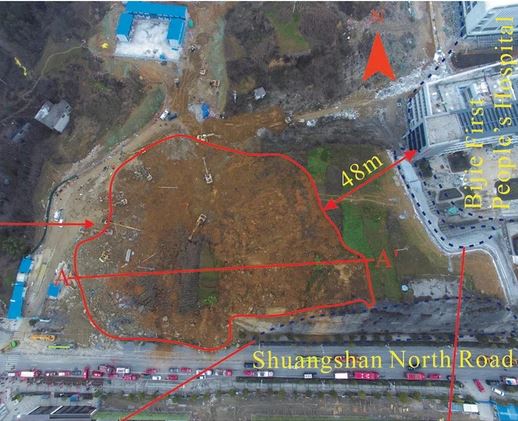29 September 2022
The causes of the 3 January 2022 landslide at Bijie City in Guizhou Province, China
Posted by Dave Petley
The causes of the 3 January 2022 landslide at Bijie City in Guizhou Province, China
On 3 January 2022 a major landslide occurred in the Jinhaihu District of Bijie City in Guizhou Province, China. The landslide, which occurred at a construction site, killed 14 people, whilst a further three people were injured. The causes of this landslide have been reviewed in a paper (Tao et al. 2022) published in the journal Landslides.
The location of the landslide is 27.233, 105.463. The site, which was excavated to allow construction of a training facility for Bijie First People’s Hospital, consisted of a slope that was cut to create three benches. The image below, from the paper, provides a drone overview of the aftermath of the landslide:-

The aftermath of the landslide 3 January 2022 landslide at Bijie in China. Image from Tao et al. (2022).
.
The topography of the slope was not steep – just 15 degrees. On the day of the landslide, 18 mm of rainfall fell, although there had been some snowfall and melt in late December that may have contributed to the groundwater level. It appears that it was high pore water pressures that triggered the failure.
The underlying cause of the landslide was the geological setting. The site was a dip slope, in which there was a weak geological layer orientated sub-parallel (at 13 degrees) to the topographic slope. The strata consisted of intensely weathered mudstones sitting over weak sandstones. Excavation of the slope exposed a thin (3 cm), particularly weak layer in the underlying sandstones, creating a free face that allowed sliding. Joints towards the crown of the slope provided further weakness and allowed infiltration of water.
The slope has undergone a smaller failure in October 2021, but construction continued. The landslide of 3 January 2022 had a volume of 35,000 cubic metres, a length of 77 m and a thickness of up to 8 m. The debris moved about 30 m. Failure occurred over about 15 seconds.
Tao et al. (2022) appear to have been careful not to ascribe blame for the landslide, but the event asks some interesting questions for me:
- Did the ground investigation identify the existence of the dip slope condition and the presence of the weak interlayer?
- Did the design recognise the potential for failure, and if so how was this to be managed?
- Given the 20,000 cubic metre failure in October 2021, was there a reconsideration of the geological setting of the site, and was the design or construction plan changed?
- Was there monitoring at the site? If not, why not? Were there any signs of the development of instability prior to the failure?
This is a really interesting example of a failure triggered during construction. One aim of site investigation and detailed design is to avoid the devastating consequences of a failure of this type. The landslide at Bijie city is a great case study that illustrate what happens when this does not go to plan.
.
Reference
Tao, T., Shi, W., Liang, F. et al. 2022. Failure mechanism and evolution of the Jinhaihu landslide in Bijie City, China, on January 3, 2022. Landslides. https://doi.org/10.1007/s10346-022-01957-w


 Dave Petley is the Vice-Chancellor of the University of Hull in the United Kingdom. His blog provides commentary and analysis of landslide events occurring worldwide, including the landslides themselves, latest research, and conferences and meetings.
Dave Petley is the Vice-Chancellor of the University of Hull in the United Kingdom. His blog provides commentary and analysis of landslide events occurring worldwide, including the landslides themselves, latest research, and conferences and meetings.
Thank for your comments on the Jinhaihu landslide, I am the corrcorresponding author.
The landslide is a really interesting example of a failure triggered during construction as you say.
I try to answer your questions :
1、According to our investigation. The designer and site investigator didn’t identify the existence of the dip slope condition and the presence of the weak interlayer.
2. The designer recognised the potential for failure, but didn’t recognise the presence of the weak interlayer.
3. There wasn’t a reconsideration of the geological setting of the site, and redesign plan .
4. There haven’t monitoring devices at the site.I think there are signs of the development of instability prior to the failure,but it didn’t receive the attention of the construction.
Thank for your attention and advice. We hanve submitted an article to Natural Hazrads , hope discuss and answer some issues in depth.